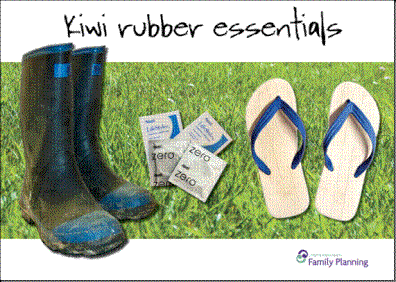Update From Family Planning
As Kiwi as…

Click to enlarge
Gumboots, jandals, condoms are three Kiwi rubber essentials according to Family Planning and are the focus of a campaign designed to get New Zealanders talking about condoms and practising safer sex.
Family Planning Chief Executive Jackie Edmond says condoms with lube, when used consistently and correctly, are the best protection against STIs (including HIV).
“We hope this simple summer campaign will be a conversation starter and alongside all our other clinical and education work, will motivate people to change their behaviour,” Ms Edmond says. “ We’d like to see condoms, and looking after your own and your partner’s sexual health as strong a part of Kiwi culture as wearing jandals and gumboots.”
“We want people to be making informed choices about sex – especially during summer when a combination of summer, holidays, sun and alcohol can result in people of all ages behaving in a manner they wouldn’t normally.”
Thousands of posters are being pasted on sites across New Zealand over summer to promote the use of condoms and Ms Edmond says health promoters and other Family Planning staff working over the summer will have t-shirts featuring the campaign image.
Family Planning has developed this campaign in conjunction with condom maker Ansell and is delighted with figures issued recently by Ansell which indicate New Zealand condom sales rose 13.5 per cent in the week before Christmas 2008.
“We hope this is a trend which continued in 2009 and into 2010 and beyond,” Ms Edmond says. “We think these figures show that New Zealanders understand that taking risks with your sexual and reproductive health can have consequences that last a lifetime and are just not worth it.”
Busting the five most common condom myths.
Myth 1: You have to be 18 to buy condoms.
Fact: Anyone of any age can buy condoms. They are
available from chemists, supermarkets and other retailers.
You can also get them on prescription your Family Planning
Clinic – which is much cheaper. And, while you’re there
you can talk about your long-term contraceptive needs and
get a sexual health check-up. If you’re under 22, this
visit will be free.
Myth 2: Condoms frequently break
Fact: Statistics show that a condom is less likely
to break when lubricated properly with a condom-safe water
based lubricant. Putting lube on the outside of the condom
will greatly reduce the chance of the condom breaking due to
friction. Heat can also increase the chance of your condom
breaking. So, if you’ve been storing them in the glovebox
of your car, your wallet, or anywhere else where they’ve
been warmed – throw them out and get a new supply.
Myth 3: HIV can pass through condoms
Fact: A
commonly held misperception is that latex contains tiny
“holes” that allow the passage of the HIV virus. This is
false. Studies provided by the Centres for Disease Control
and the World Health Organisation show that intact latex
condoms provide a highly effective barrier to sperm and
micro-organisms including HIV and the much smaller Hepatitis
B virus.
Myth 4: If I ask to use a condom, my partner
will think less of me.
Fact: Insisting that you use
a condom suggests that you know how to take care of yourself
and shows that you know what you want. Talk with your
partner about using condoms and keeping yourselves safe
before you start having sex.
Myth 5: I don’t need to
use condoms – I only sleep with nice people.
Fact:
STIs don’t know or care if you’re nice or not. The way
someone looks is no indicator of where they have an STI.
And, many STIs have no symptoms so you could infect each
other without knowing it. Until the relationship is
monogamous and you’ve both been tested and cleared, you
should use condoms every time.
ENDS


 Cross Street Music Festival: First Artists Announced For 2025 Cross Street Music Festival
Cross Street Music Festival: First Artists Announced For 2025 Cross Street Music Festival Bowls New Zealand: Lawson And Grantham Qualify To Keep Bowls Three-Peat Hopes Alive
Bowls New Zealand: Lawson And Grantham Qualify To Keep Bowls Three-Peat Hopes Alive Te Whatu Ora Health NZ: Health Warning – Unsafe Recreational Water Quality At South Bay And Peketā Beaches And Kahutara River Upstream Of SH1
Te Whatu Ora Health NZ: Health Warning – Unsafe Recreational Water Quality At South Bay And Peketā Beaches And Kahutara River Upstream Of SH1 Wikimedia Aotearoa NZ: Wikipedian At Large Sets Sights On Banks Peninsula
Wikimedia Aotearoa NZ: Wikipedian At Large Sets Sights On Banks Peninsula Water Safety New Zealand: Don’t Drink And Dive
Water Safety New Zealand: Don’t Drink And Dive NZ Olympic Committee: Lydia Ko Awarded Lonsdale Cup For 2024
NZ Olympic Committee: Lydia Ko Awarded Lonsdale Cup For 2024